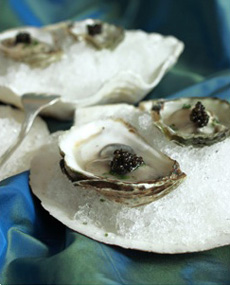

A double delight: oysters with caviar. Photo courtesy Caviar Russe | NYC.
July 2007
Last Updated January 2013
|
 |
Oyster Information
Page 2: The Flavor Of Oysters
CAPSULE REPORT: This is page two of a nine-page article of oyster information, including a six-page oyster glossary. Click on the black links below to visit other pages. If you love oysters as much as we do, you’ll devour every word—with or without cocktail sauce. We have many other food glossaries that include other favorite foods as well, including a 13-page Seafood Glossary.
The Flavor Of Oysters
Even within the same species and general area—the East Coast Virginica, for example—the flavor of oysters will vary in both nuances and salinity, based on their terroir, the environment and chemical composition of the waters in which they grow. As a mollusk, the oyster constantly sieves water for its food (clams and mussels do the same). Thus, the nutrients in the water, and their particular flavors, constantly flow over the meat. Similarly, the temperature of the water impacts the flesh: Cold water oysters (from Maine or Nova Scotia) are more firm than warm water oysters (from Virginia or Florida). Colder water oysters are generally saltier, with crisper flavors.
Eat enough oysters and you will become very sensitive to the differences in flavor.
- Oyster connoisseurs refer to the quality and flavor as briny or salty; buttery or creamy. A substantive oyster is meaty or plump.
- The terroir can impart the tastes of kelp or other seaweed, mineral or metallic flavors.
- Like wine and olive oil, oysters have nuances of other flavors from nature including berries, citrus, melon or general fruitiness. Other oysters have vegetal flavors; or nuttiness. (Pacific northwest oysters are known for their watermelon and cucumber notes—more melony in the Washington area and more cucumber nuances in British Columbia.)
- The more nutrients in the water, the plumper the flesh, and the more flavorful.
- Terroir has microclimates: products grown or raised not far from each other can have different flavors. For example, Fanny Bay and Denman Island oysters are cultivated on the beach not far from each other, both on the east coast of Vancouver Island. They are very similar in meatiness, sweetness and saltiness. Yet, Fanny Bays have a cucumber finish (or aftertaste), while Denman Island’s unique microclimate gives its oysters a watermelon finish.
Now, we’ll be moving to the main body of this article, the Oyster Glossary, where you’ll learn about the breadth of varieties of oysters.
Continue To Page 3: Types Of Oysters Beginning With A & B
Go To The Article Index Above

|




